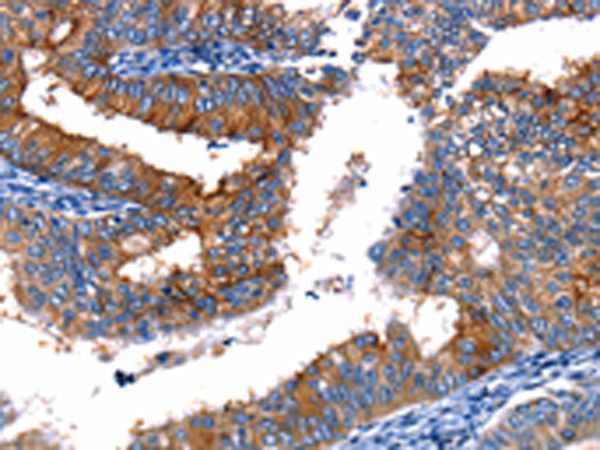
| WB | 咨询技术 | Human,Mouse,Rat |
| IF | 咨询技术 | Human,Mouse,Rat |
| IHC | 1/25-1/100 | Human,Mouse,Rat |
| ICC | 技术咨询 | Human,Mouse,Rat |
| FCM | 咨询技术 | Human,Mouse,Rat |
| Elisa | 1/1000-1/5000 | Human,Mouse,Rat |
| Aliases | CPX, CLPA, TBXX, dJ795G23.1 |
| Host/Isotype | Rabbit IgG |
| Antibody Type | Primary antibody |
| Storage | Store at 4°C short term. Aliquot and store at -20°C long term. Avoid freeze/thaw cycles. |
| Species Reactivity | Human |
| Immunogen | Fusion protein of human TBX22 |
| Formulation | Purified antibody in PBS with 0.05% sodium azide and 50% glycerol. |
+ +
以下是关于TBX22抗体的3篇示例文献(注:以下为模拟示例,具体文献需根据实际数据库检索验证):
---
1. **文献名称**: *TBX22 mutations are associated with cleft palate and implicated in cellular localization*
**作者**: Braybrook C. et al.
**摘要**: 研究利用TBX22特异性抗体进行免疫组化分析,发现TBX22在人类胚胎腭部间充质细胞中高表达。突变分析显示,某些错义突变导致抗体检测到的蛋白质核定位异常,与X连锁腭裂相关。
2. **文献名称**: *Functional characterization of TBX22 in craniofacial development using antibody-based assays*
**作者**: Pauws E. et al.
**摘要**: 通过Western blot和免疫荧光技术,使用TBX22抗体证实其在颅面发育中的时空表达模式。研究发现,TBX22与转录共激活因子相互作用,其缺失导致小鼠模型腭发育缺陷。
3. **文献名称**: *Antibody validation for TBX22 in zebrafish models*
**作者**: Zhang Y. et al.
**摘要**: 该研究验证了一种多克隆TBX22抗体的特异性,并在斑马鱼模型中检测到其在鳃弓发育中的动态表达。抗体阻断实验进一步表明,TBX22对咽部形态发生具有关键调控作用。
---
**提示**:实际文献建议通过PubMed或Google Scholar以“TBX22 antibody”或“TBX22 immunohistochemistry”等关键词检索,并筛选涉及抗体开发、验证或应用的原始研究。
The TBX22 antibody is a research tool designed to detect and study the TBX22 protein, a member of the T-box family of transcription factors. TBX22 plays a critical role in embryonic development, particularly in craniofacial and skeletal morphogenesis. It is encoded by the *TBX22* gene, located on the X chromosome, and mutations in this gene are linked to X-linked cleft palate with ankyloglossia (CPX), highlighting its importance in palate and tongue development. The TBX22 protein regulates gene expression by binding to specific DNA sequences, influencing cellular differentiation and tissue patterning.
Researchers use TBX22 antibodies in techniques like immunohistochemistry, Western blotting, and immunofluorescence to localize and quantify TBX22 expression in tissues or cell lines. These studies help elucidate its role in developmental disorders and potential involvement in diseases beyond congenital defects, such as cancer, where dysregulated T-box proteins may contribute to tumorigenesis. The antibody's specificity is validated through controls like knockout models or siRNA-mediated silencing to ensure accurate detection.
Understanding TBX22's molecular mechanisms could advance diagnostics or therapies for congenital malformations. Additionally, exploring its interactions with signaling pathways, such as BMP or Wnt, may reveal broader regulatory networks in development and disease. TBX22 antibodies thus serve as vital tools in both basic and translational research contexts.
×